Community Solar Operation Strategy for Smart Energy Communities Considering Resource Fairness
Abstract
:1. Introduction
- Distributed operation: The baseline problem is formulated as a mixed-integer linear programming problem that considers the minimization of the overall electricity bill and resource fairness. To design the distributed operation, the problem is decomposed into two problems using the slack variable, for the community smart energy service provider (SESP) and community members. Each member solves the community solar operation problem by minimizing their own electricity bill using resource constraints. The SESP manages the required operational results, as shown in Figure 1. It is converged in an iterative manner based on information exchange between the SESP and the members.
- Partial information usage: To select the correct operation while considering resource fairness, information on the future time is required. This is because the priority of all decision times must be measured to determine the optimal solution. In this study, the forecasted values of the demand and generation were obtained using forecasting techniques. Due to forecast errors, a mismatch occurs between the resource allocation constraint and actual allocation. It is defined as the residual allocation factor. This factor is used as a priority factor to determine the operation at each decision time. Therefore, community solar operations are decided at each decision time and not for all decision times.
- Experimental results and discussions on a real data set: The proposed community solar operation was performed using a real data set obtained in Korea. To verify its performance, the overall electricity bill savings, distribution of electricity bill savings, performance gap with respect to the baseline problem, and fairness indices were measured by varying the community solar capacity. The experimental results show that by using the proposed operation, members in the SEC can achieve fairly distributed electricity bill savings, and the benefit reduction of the overall electricity bill saving is marginally less than 10% compared to the baseline operation that requires a centralized controller and perfect information, including the future time. Moreover, the effects of fairness and future research prospects of community solar operations are also discussed.
2. Method
2.1. Model
2.2. Problem Formulation
3. Proposed Community Solar Operation Strategy for SEC
| Proposed community solar operation strategy |
| Initialization Demand and generation forecasting, and Set the maximum iteration. At each decision time , Each member calculates using Equation (20) and sends it to the SESP. The SESP calculates using Equation (11) and sends it back to each member. The process is repeated until convergence or the maximum iteration is reached. |
4. Results
4.1. Experimental Environment
4.2. Electricity Bill Saving
4.3. Fairness
5. Discussion
- The central objective of the community solar operation strategy in P0 is to maximize the overall electricity bill savings of the members; however, the strategy requires information on the future time. The proposed distributed strategy with partial information has a slightly less electricity bill savings compared to P0, as shown in Table 2. However, the optimal gap was less than 10% without the consideration of a small community solar capacity of 50 kWp, as shown in Figure 7. Moreover, the proposed strategy distributes the electricity bill savings of the members more fairly than the strategy in P0. This verified the effectiveness of the proposed community solar operation strategy.
- The savings on the electricity bill were directly proportional to the community solar capacity, as shown in Table 2. However, the efficiency, measured as the electricity bill savings per capacity, was reduced with increasing community solar capacity, as shown in Figure 8. Moreover, increasing the community solar capacity requires additional investment from the SEC members; thus, an appropriate community solar capacity implementation is required when configuring a community solar system for the SEC.
- The fixed proportional operation strategy presented as PP has a large optimal performance gap compared to the centralized and proposed operation strategies, as shown in Figure 7. However, the electricity bill savings per community solar capacity in the PP strategy were decreased with increasing community solar capacity, as shown in Figure 8. Particularly, the Jain’s fairness index of PP was closest to the optimal value (c.f., the optimal Jain’s fairness index is 1), as shown in Figure 9. This implies that the PP strategy can be used as a baseline community solar operation strategy for SECs.
- In this study, the implementation cost of community solar power was neglected. As discussed above, by increasing the community solar capacity, the benefits of electricity bill savings and cost of generation are also increased. Therefore, the community solar implementation issue can be investigated in future research considering the trade-off between the benefits and costs.
- This study assumed a case in which the SESP implemented and operated community solar generation and distribution. This can be extended to a case where third-party service providers such as a community solar service providers (CSSP) are used to implement community solar generation and the SESP rents the community solar capacity. In the extended case, the benefit distribution between the CSSP and members of the SEC can be formulated as a new problem.
- This study did not consider the energy transaction constraints such as transmission and distribution congestion and cost because the SEC consists of members in close proximity to each other. Therefore, this study can be extended to large-scale grid connection systems by considering the energy transaction constraints.
6. Conclusions
Funding
Institutional Review Board Statement
Informed Consent Statement
Data Availability Statement
Conflicts of Interest
References
- Mohsin, M.; Taghizadeh-Hesary, F.; Iqbal, N.; Saydaliev, H.B. The role of technological progress and renewable energy deployment in green economic growth. Renew. Energy 2022, 190, 777–787. [Google Scholar] [CrossRef]
- Niu, S.; Zhang, Z.; Ke, X.; Zhang, G.; Huo, C.; Qin, B. Impact of renewable energy penetration rate on power system transient voltage stability. Energy Rep. 2022, 8, 487–492. [Google Scholar] [CrossRef]
- Panda, S.; Mohanty, S.; Rout, P.K.; Sahu, B.K.; Parida, S.M.; Kotb, H.; Flah, A.; Tostado-Véliz, M.; Abdul Samad, B.; Shouran, M. An insight into the integration of distributed energy resources and energy storage systems with smart distribution networks using demand-side management. Appl. Sci. 2022, 12, 8914. [Google Scholar] [CrossRef]
- Guo, M.; Xia, M.; Chen, Q. A review of regional energy internet in smart city from the perspective of energy community. Energy Rep. 2022, 8, 161–182. [Google Scholar] [CrossRef]
- Smale, R.; Kloppenburg, S. Platforms in power: Householder perspectives on the social, environmental and economic challenges of energy platforms. Sustainability 2020, 12, 692. [Google Scholar] [CrossRef] [Green Version]
- Oh, E. Fair Virtual Energy Storage System Operation for Smart Energy Communities. Sustainability 2022, 14, 9413. [Google Scholar] [CrossRef]
- Monie, S.; Nilsson, A.M.; Widén, J.; Åberg, M. A residential community-level virtual power plant to balance variable renewable power generation in Sweden. Energy Convers. Manag. 2021, 228, 113597. [Google Scholar] [CrossRef]
- Klein, S.J.; Hargreaves, A.; Coffey, S. A financial benefit-cost analysis of different community solar approaches in the Northeastern US. Sol. Energy 2021, 213, 225–245. [Google Scholar] [CrossRef]
- Ang, T.Z.; Salem, M.; Kamarol, M.; Das, H.S.; Nazari, M.A.; Prabaharan, N. A comprehensive study of renewable energy sources: Classifications, challenges and suggestions. Energy Strategy Rev. 2022, 43, 100939. [Google Scholar] [CrossRef]
- Hou, J.; Wang, J.; Zhou, Y.; Lu, X. Distributed energy systems: Multi-objective optimization and evaluation under different operational strategies. J. Clean. Prod. 2021, 280, 124050. [Google Scholar] [CrossRef]
- Tomin, N.; Shakirov, V.; Kozlov, A.; Sidorov, D.; Kurbatsky, V.; Rehtanz, C.; Lora, E.E. Design and optimal energy management of community microgrids with flexible renewable energy sources. Renew. Energy 2022, 183, 903–921. [Google Scholar] [CrossRef]
- Funkhouser, E.; Blackburn, G.; Magee, C.; Rai, V. Business model innovations for deploying distributed generation: The emerging landscape of community solar in the US. Energy Res. Soc. Sci. 2015, 10, 90–101. [Google Scholar] [CrossRef]
- Peters, M.; Fudge, S.; High-Pippert, A.; Carragher, V.; Hoffman, S.M. Community solar initiatives in the United States of America: Comparisons with–and lessons for–the UK and other European countries. Energy Policy 2018, 121, 355–364. [Google Scholar] [CrossRef]
- Michaud, G. Perspectives on community solar policy adoption across the United States. Renew. Energy Focus 2020, 33, 1–15. [Google Scholar] [CrossRef]
- Shakouri, M.; Lee, H.W.; Kim, Y.W. A probabilistic portfolio-based model for financial valuation of community solar. Appl. Energy 2017, 191, 709–726. [Google Scholar] [CrossRef]
- Schunder, T.; Yin, D.; Bagchi-Sen, S.; Rajan, K. A spatial analysis of the development potential of rooftop and community solar energy. Remote Sens. Appl. Soc. Environ. 2020, 19, 100355. [Google Scholar] [CrossRef]
- Huang, P.; Sun, Y.; Lovati, M.; Zhang, X. Solar-photovoltaic-power-sharing-based design optimization of distributed energy storage systems for performance improvements. Energy 2021, 222, 119931. [Google Scholar] [CrossRef]
- Lee, S.; Shenoy, P.; Ramamritham, K.; Irwin, D. AutoShare: Virtual community solar and storage for energy sharing. Energy Inform. 2021, 4, 10. [Google Scholar] [CrossRef]
- Cosic, A.; Stadler, M.; Mansoor, M.; Zellinger, M. Mixed-integer linear programming based optimization strategies for renewable energy communities. Energy 2021, 237, 121559. [Google Scholar] [CrossRef]
- Khezri, R.; Mahmoudi, A.; Aki, H. Optimal planning of solar photovoltaic and battery storage systems for grid-connected residential sector: Review, challenges and new perspectives. Renew. Sustain. Energy Rev. 2022, 153, 111763. [Google Scholar] [CrossRef]
- Tsaousoglou, G.; Pinson, P.; Paterakis, N.G. Max-min fairness for demand side management under high RES penetration: Dealing with undefined consumer valuation functions. In Proceedings of the 2020 International Conference on Smart Energy Systems and Technologies (SEST), Istanbul, Turkey, 7–9 September 2020. [Google Scholar]
- Tsaousoglou, G.; Giraldo, J.S.; Pinson, P.; Paterakis, N.G. Mechanism design for fair and efficient dso flexibility markets. IEEE Trans. Smart Grid 2021, 12, 2249–2260. [Google Scholar] [CrossRef]
- Hupez, M.; Toubeau, J.F.; De Grève, Z.; Vallée, F. A new cooperative framework for a fair and cost-optimal allocation of resources within a low voltage electricity community. IEEE Trans. Smart Grid 2021, 12, 2201–2211. [Google Scholar] [CrossRef]
- Grzanic, M.; Morales, J.M.; Pineda, S.; Capuder, T. Electricity cost-sharing in energy communities under dynamic pricing and uncertainty. IEEE Access 2021, 9, 30225–30241. [Google Scholar] [CrossRef]
- Oh, E.; Son, S.Y. Community solar photovoltaic service strategy for commercial buildings considering profit balancing and fairness. Energy Build. 2020, 229, 110513. [Google Scholar] [CrossRef]
- Lessons Learned: Community Solar for Municipal Utilities. National Renewable Energy Laboratory (NREL). Available online: https://www.nrel.gov/docs/fy17osti/67442.pdf (accessed on 10 November 2022).
- Ozcan, E.; Erol, S. A multi-objective mixed integer linear programming model for energy resource allocation problem: The case of Turkey. Gazi Univ. J. Sci. 2014, 27, 1157–1168. [Google Scholar]
- Bertsimas, D.; Farias, V.F.; Trichakis, N. The price of fairness. Oper. Res. 2011, 59, 17–31. [Google Scholar] [CrossRef] [Green Version]
- Boyd, S.; Boyd, S.P.; Vandenberghe, L. Convex Optimization; Cambridge University Press: Cambridge, UK, 2004. [Google Scholar]
- Giselsson, P.; Doan, M.D.; Keviczky, T.; De Schutter, B.; Rantzer, A. Accelerated gradient methods and dual decomposition in distributed model predictive control. Automatica 2013, 49, 829–833. [Google Scholar] [CrossRef] [Green Version]
- Hong, M.; Garcia, A. Averaged iterative water-filling algorithm: Robustness and convergence. IEEE Trans. Signal Process. 2011, 59, 2448–2454. [Google Scholar] [CrossRef]
- Rao, S.N.V.B.; Yellapragada, V.P.K.; Padma, K.; Pradeep, D.J.; Reddy, C.P.; Amir, M.; Refaat, S.S. Day-Ahead Load Demand Forecasting in Urban Community Cluster Microgrids Using Machine Learning Methods. Energies 2022, 15, 6124. [Google Scholar] [CrossRef]
- Zhang, G.; Yang, D.; Galanis, G.; Androulakis, E. Solar forecasting with hourly updated numerical weather prediction. Renew. Sustain. Energy Rev. 2022, 154, 111768. [Google Scholar] [CrossRef]
- Yang, W.; Kang, H.; Kwon, Y.; Yoon, Y. Energy Moving the World: Micro Energy Grid; K-MEG RD Center: Seoul, Republic of Korea, 2004; ISBN 978-89-94792-95-815320. [Google Scholar]
- A-10 Medium General Demand-Metered Service. Pacific Gas and Electric Company (PG&E). 2021. Available online: https://www.pge.com/tariffs/index.page (accessed on 10 November 2022).
- Rochim, A.F.; Muis, A.; Sari, R.F. A discrimination index based on Jain’s fairness index to differentiate researchers with identical H-index Values. J. Data Inf. Sci. 2020, 5, 5–18. [Google Scholar] [CrossRef]

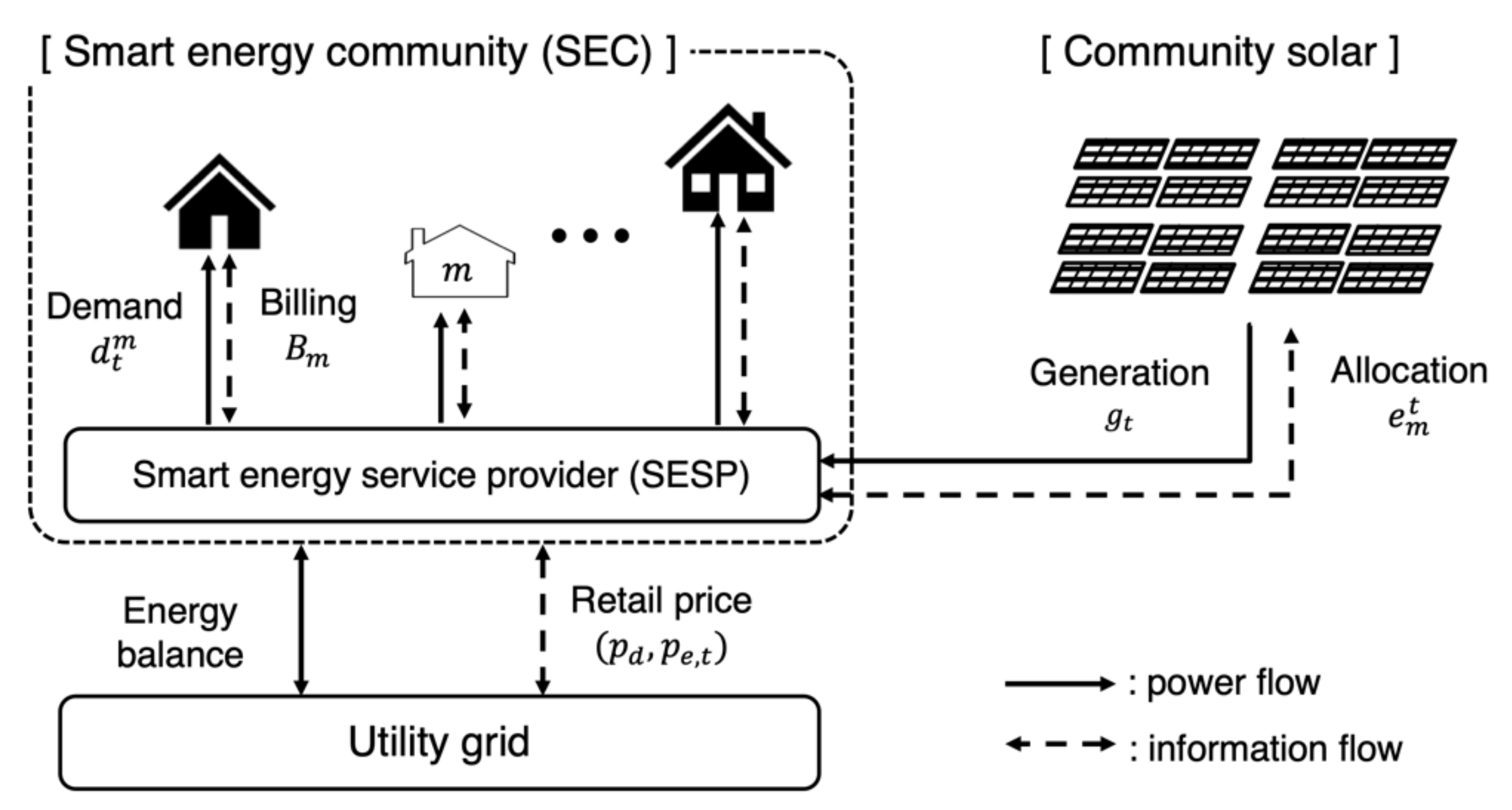
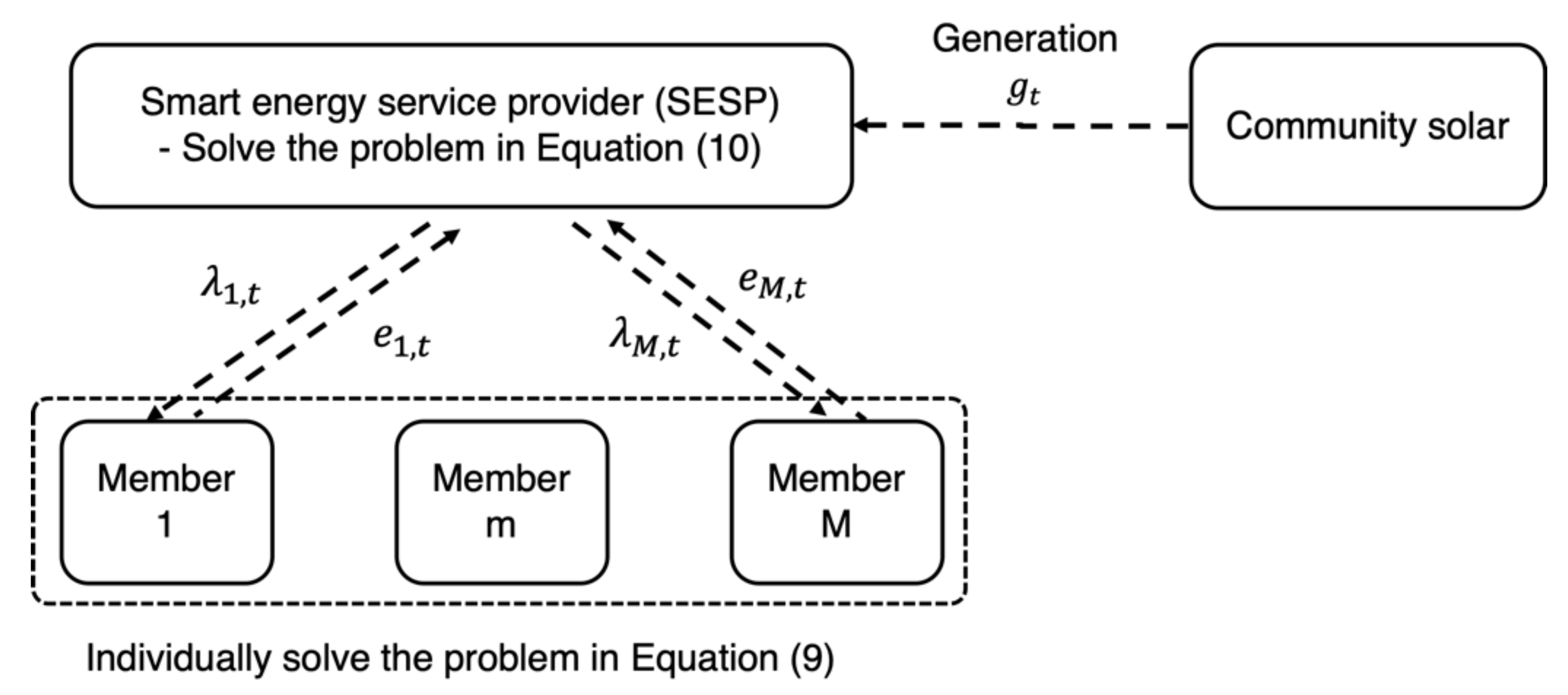



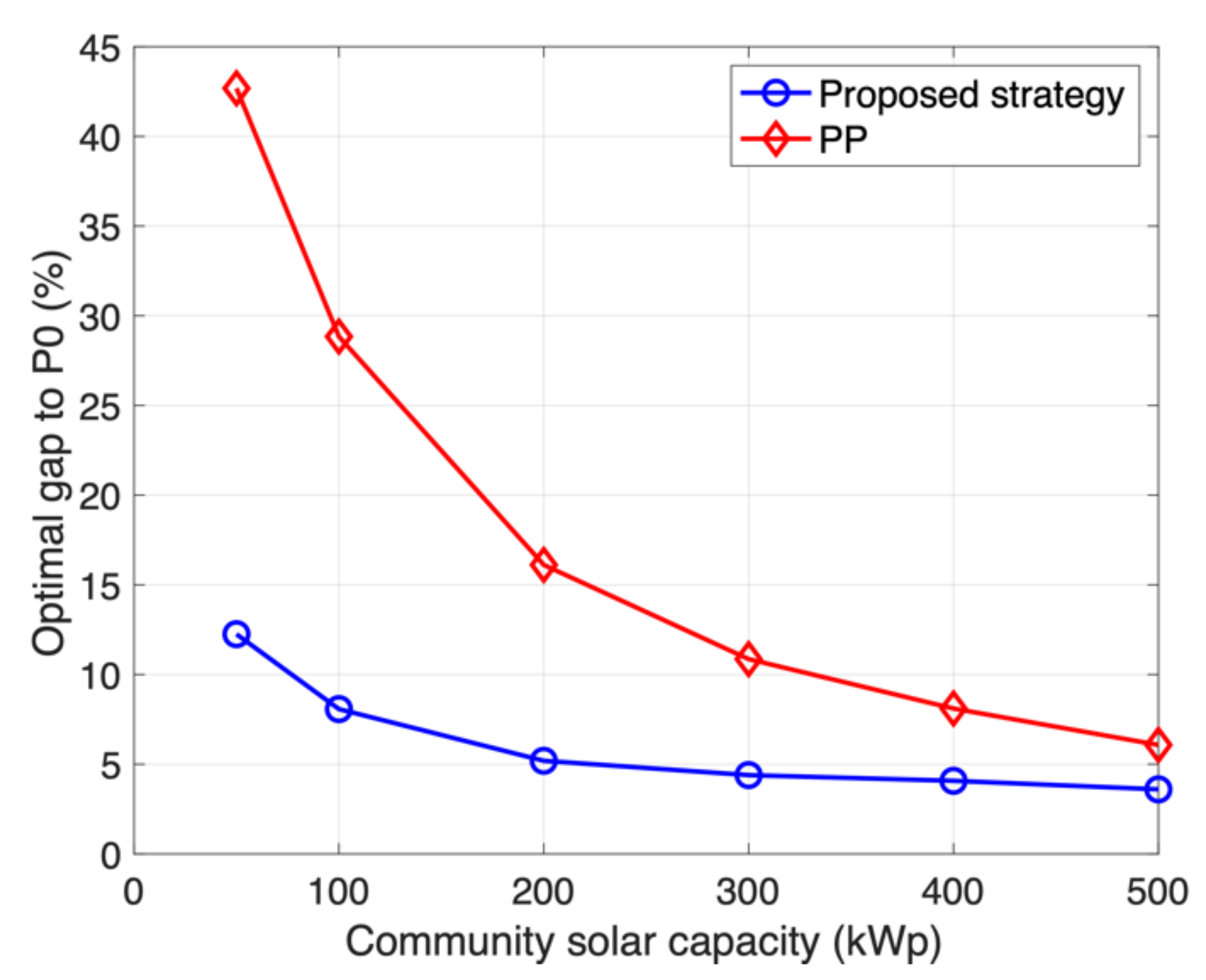
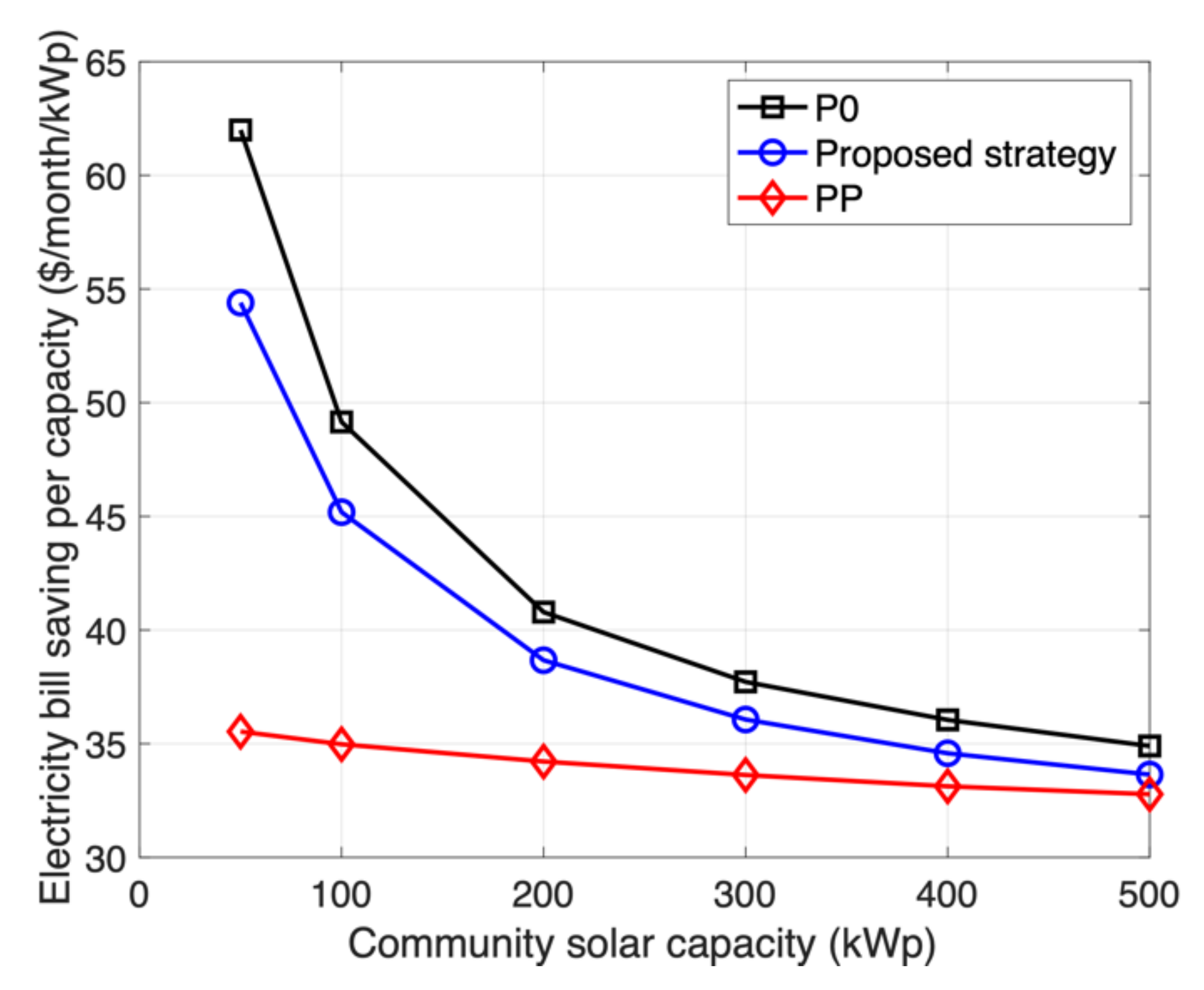
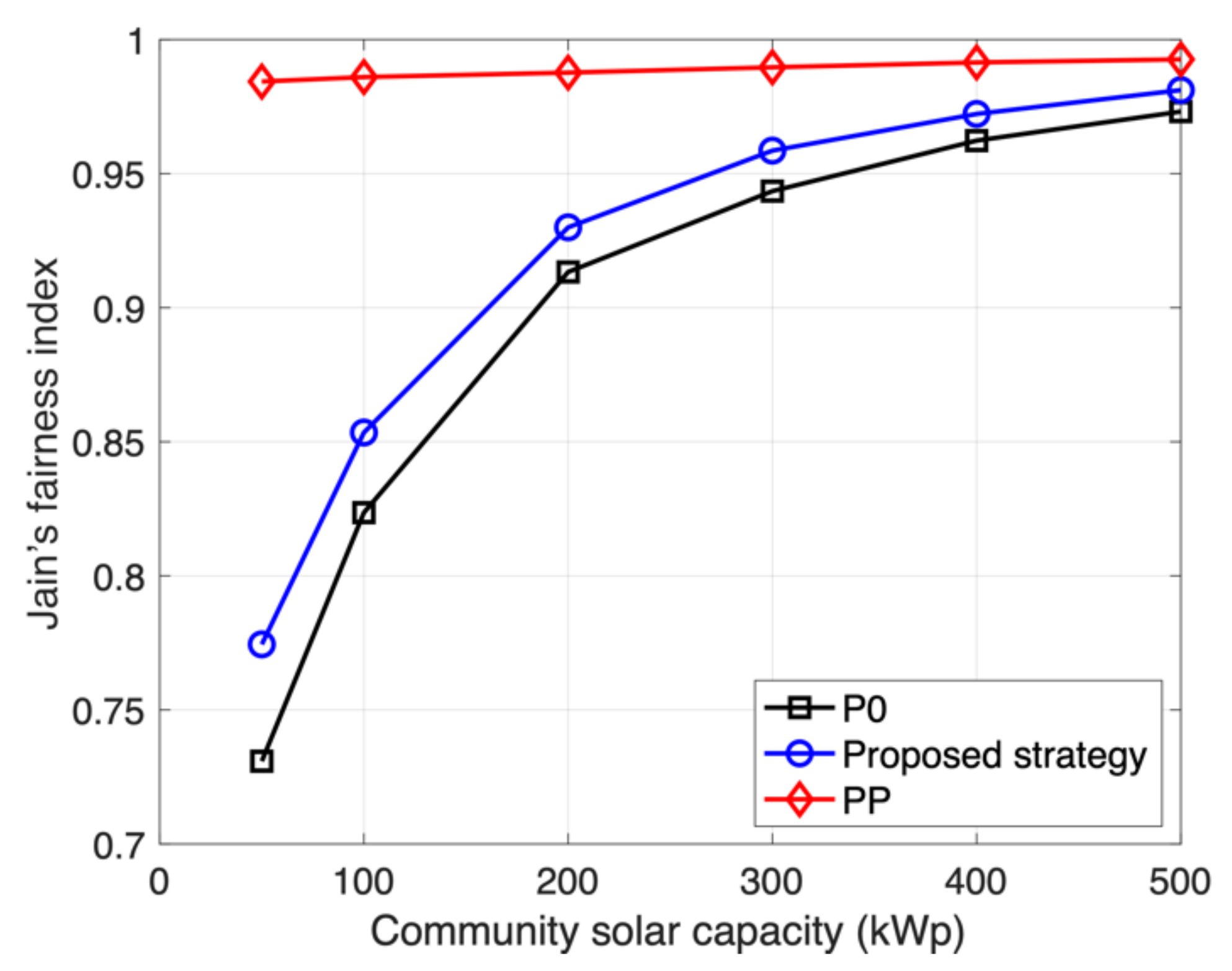

| Demand Price (USD/kW) | Energy Price (USD/kWh) | ||
|---|---|---|---|
| Off-Peak | Mid-Peak | On-Peak | |
| 18.45 | 0.22 | 0.25 | 0.25 |
| Method | Community Solar Capacity | |||||
|---|---|---|---|---|---|---|
| 50 kWp | 100 kWp | 200 kWp | 300 kWp | 400 kWp | 500 kWp | |
| P0 | 3100 | 4915 | 8158 | 11,316 | 14,419 | 17,450 |
| Proposed strategy | 2720 | 4518 | 7734 | 10,819 | 13,832 | 16,822 |
| PP | 1777 | 3498 | 6843 | 10,087 | 13,251 | 16,389 |
Disclaimer/Publisher’s Note: The statements, opinions and data contained in all publications are solely those of the individual author(s) and contributor(s) and not of MDPI and/or the editor(s). MDPI and/or the editor(s) disclaim responsibility for any injury to people or property resulting from any ideas, methods, instructions or products referred to in the content. |
© 2022 by the author. Licensee MDPI, Basel, Switzerland. This article is an open access article distributed under the terms and conditions of the Creative Commons Attribution (CC BY) license (https://creativecommons.org/licenses/by/4.0/).
Share and Cite
Oh, E. Community Solar Operation Strategy for Smart Energy Communities Considering Resource Fairness. Appl. Sci. 2022, 12, 12867. https://doi.org/10.3390/app122412867
Oh E. Community Solar Operation Strategy for Smart Energy Communities Considering Resource Fairness. Applied Sciences. 2022; 12(24):12867. https://doi.org/10.3390/app122412867
Chicago/Turabian StyleOh, Eunsung. 2022. "Community Solar Operation Strategy for Smart Energy Communities Considering Resource Fairness" Applied Sciences 12, no. 24: 12867. https://doi.org/10.3390/app122412867






